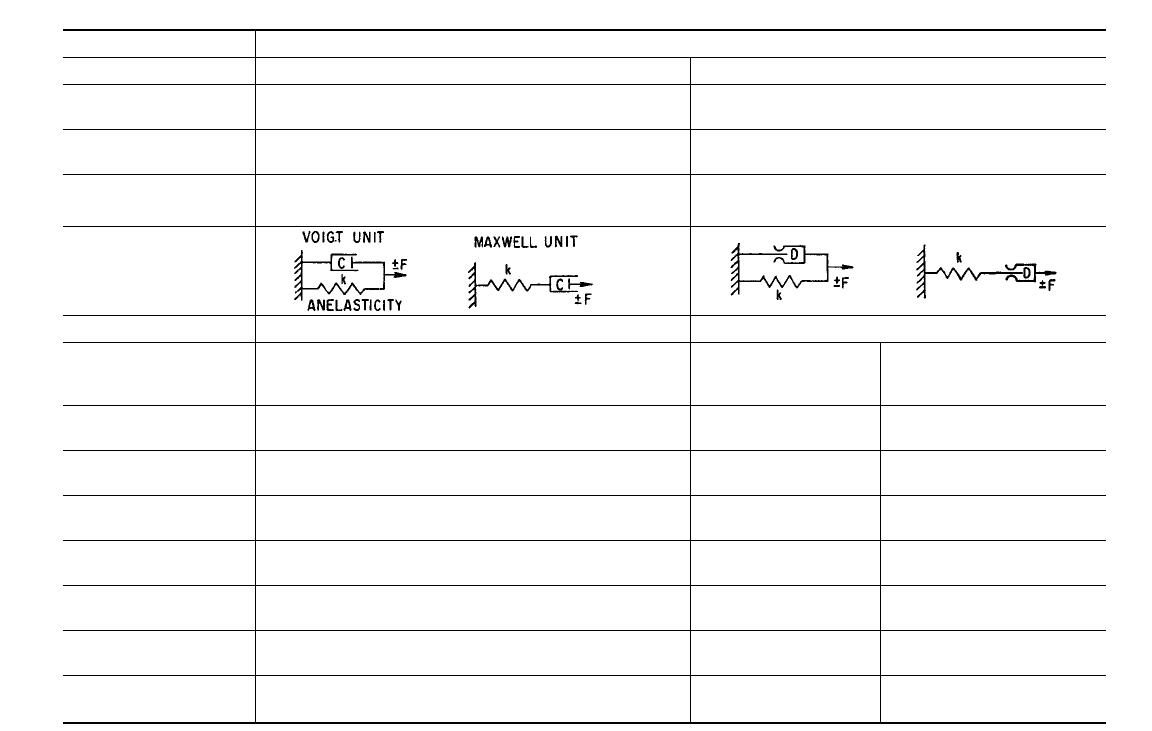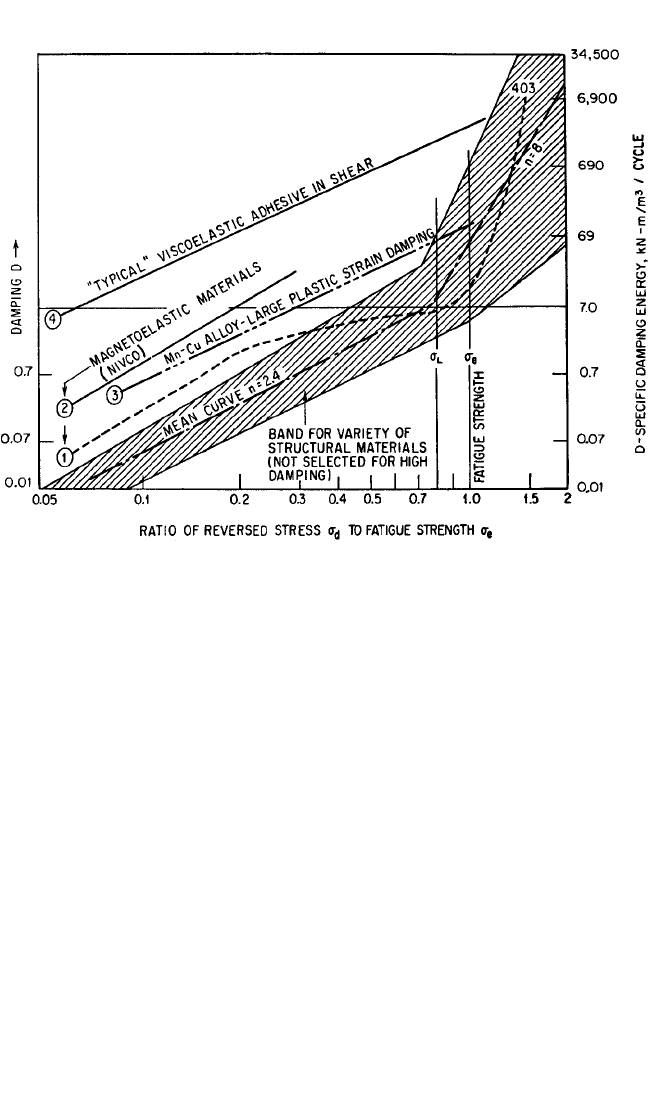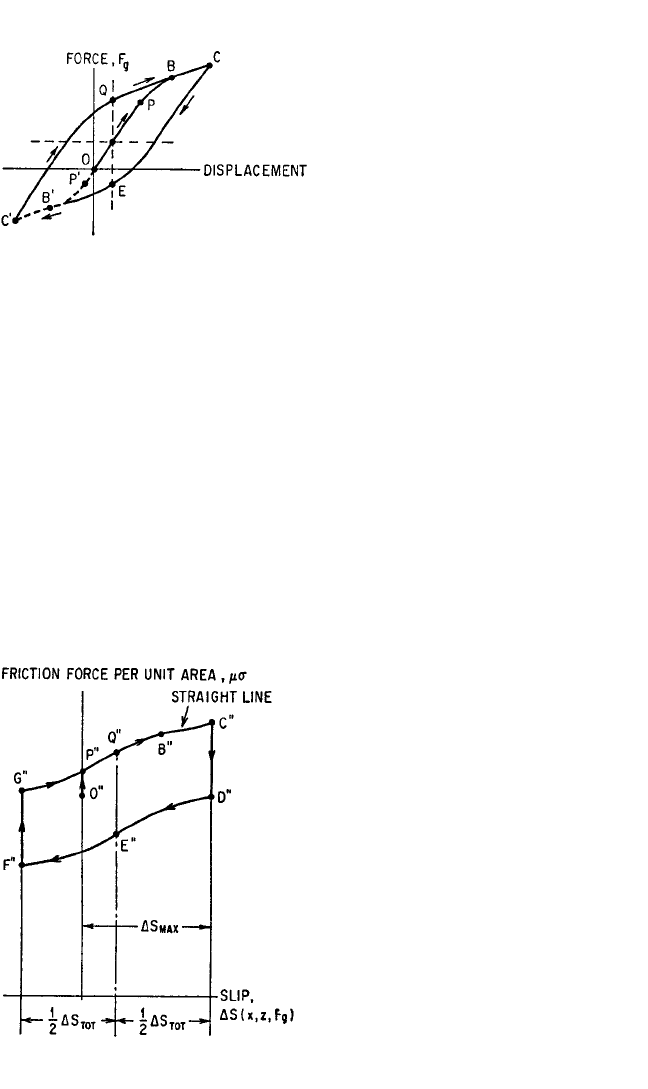Harris C.M., Piersol A.G. Harris Shock and vibration handbook
Подождите немного. Документ загружается.


1. Condition of the material
a. In virgin state: chemical composition; constitution (or structure) due to ther-
mal and mechanical treatment; inhomogeneity effects
b. During and after exposure to pretreatment, test, or service condition:
Effect of stress and temperature histories on aging, precipitation, and other
metallurgical solid-state transformations
2. State of internal stress
a. Initially, due to surface-finishing operations (shot peening, rolling, case
hardening)
b. Changes caused by stress and temperature histories during test or service
3. Stress imposed by test or service conditions
a. Type of stress (tension, compression, bending, shear, torsion)
b. State of stress (uniaxial, biaxial, or triaxial)
c. Stress-magnitude parameters, including mean stress and alternating compo-
nents; loading spectrum if stress amplitude is not constant
d. Characteristics of stress variations including frequency and waveform
e. Environmental conditions: temperature (magnitude and variation) and the
surrounding medium and its (corrosive, erosive, and chemical) effects
Factors tabulated above, such as stress magnitude, history, and frequency, may be
significant at one stress level or test condition and unimportant at another. The
deformation mechanism that is operative governs the sensitivity to the various fac-
tors tabulated.
Many types of inelastic mechanisms and hysteretic phenomena have been identi-
fied, as shown in Table 36.2. The various damping phenomena and mechanisms may
be classified under two main headings: dynamic hysteresis and static hysteresis.
Materials which display dynamic hysteresis (sometimes identified as viscoelastic,
rheological, and rate-dependent hysteresis) have stress-strain laws which are
describable by a differential equation containing stress, strain, and time derivatives
of stress or strain. This differential equation need not be linear, though, to avoid
mathematical complexity, much of the existing theory is based on the linear vis-
coelastic law described in the previous section. One important type of dynamic hys-
teresis, a special case identified as anelasticity
14, 15
or internal friction, produces no
permanent set after a long time. This means that if the load is suddenly removed at
point B in Fig. 36.1, after cycle OAB, strain OB will gradually reduce to zero as the
specimen recovers (or creeps negatively) from point B to point O.
A distinguishing characteristic of anelasticity and the more general case of vis-
coelastic damping is its dependence on time-derivative terms. The hysteresis loops
tend to be elliptical in shape rather than pointed as in Fig. 36.1. Furthermore, the
loop area is definitely related to the dynamic or cyclic nature of the loading and the
area of the loop is dependent on frequency. In fact, the stress-strain curve for an ide-
ally viscoelastic material becomes a single-valued curve (no hysteretic loop) if the
cyclic stress is applied slowly enough to allow the material to be in complete equi-
librium at all times (oscillation period very much longer than relaxation times). No
hysteretic damping is produced by these mechanisms if the material is subjected to
essentially static loading. Stated differently, the static hysteresis is zero.
Static hysteresis, by contrast, involves stress-strain laws which are insensitive to
time, strain, or stress rate.The equilibrium value of strain is attained almost instantly
for each value of stress and prior stress history (direction of loading, amplitudes,
etc.), independent of loading rate. Hysteresis loops are pointed, as shown in Fig. 36.1,
and if the stress is reduced to zero (point B) after cycle OAB, then OB remains as a
permanent set or residual deformation.The two principal mechanisms which lead to
static hysteresis are magnetostriction and plastic strain.
MATERIAL DAMPING AND SLIP DAMPING 36.17
8434_Harris_36_b.qxd 09/20/2001 12:28 PM Page 36.17

TABLE 36.2 Classification of Types of Hysteretic Damping of Materials
Types of material damping
Name used here Dynamic hysteresis Static hysteresis
Other names Viscoelastic, rheological, and rate-dependent hysteresis Plastic, plastic flow, plastic strain, and rate-independent
hysteresis
Nature of stress- Essentially linear. Differential equation involving stress, Essentially nonlinear, but excludes time derivatives of
strain laws strain, and their time derivatives stress or strain
Special cases Anelasticity. Special because no permanent set after
and description sufficient time. Called “internal friction”
Simplest
representative
mechanical
model
Frequency dependence Critically at relaxation peaks No, unless other mechanisms present
Primary mechanisms Solute atoms, grain boundaries. Micro- and macro-thermal Magnetoelasticity Plastic strain
and eddy currents. Molecular curling and uncurling in
polymers.
Value of n in D = JS
n
2 3—up to coercive force 2–3 up to σ
L
2 to >30 above σ
L
Variation of η with stress No change, since n − 2 = 0 Proportional to σ since Small increase up to σ
L
n − 2 = 1 Large increase above σ
L
Typical values for η Anelasticity: <0.001 to 0.01 0.01 to 0.08 0.001 to 0.05 up to σ
L
Viscoelasticity: <0.1 to >1.5
0.001 to >0.1 above σ
L
Stress range of Anelasticity—low stress Low and medium. Medium and high stress
engineering importance Viscoelasticity—all stresses Sometimes high
Effect of fatigue cycles No effect No effect No effect up to σ
L
Large changes above σ
L
Effect of temperature Critical effects near relaxation peaks Damping disappears at Mixed. Depends on type of
Curie temperature comparison
Effect of static preload
Large reduction for Either little effect or
small coercive force increase
36.18
8434_Harris_36_b.qxd 09/20/2001 12:28 PM Page 36.18

Table 36.2 also shows the simplest representative mechanical models for each of
the behaviors classified. In these models, k is a spring having linear elasticity (linear
and single-valued stress-strain curve), C is a linear dashpot which produces a resist-
ing force proportional to velocity, and D is a Coulomb friction unit which produces
a constant force whenever slip occurs within the unit, the direction of the force being
opposite to the direction of relative motion. More sophisticated models have been
found to predict reliably the behavior of some materials, particularly polymeric
materials.
Any one of the mechanisms to be discussed may dominate, depending on the
stress level. For convenience, low stress is defined here as a (tension-compression)
stress less than 1 percent of the fatigue limit; intermediate stress levels are those
between 1 percent and 50 percent of the fatigue limit of the material; and high stress
levels are those exceeding 50 percent of the fatigue limit.
DYNAMIC HYSTERESIS OF VISCOELASTIC MATERIALS
The linearity limits of a variety of plastics and rubbers are summarized in Table 36.3.
While the stress limits are of the same order of magnitude for plastics and rubbers,
the strain limits are much smaller for the former class of materials.Within these lim-
its the dynamic storage and loss moduli of linear viscoelasticity may be used.
One distinguishing characteristic of the dynamic behavior of viscoelastic materi-
als is a strong dependence on temperature and frequency.
1, 16
At high frequencies (or
low temperature) the storage modulus is large, the loss modulus is small, and the
behavior resembles that of a stiff ideal material.This is known as the “glassy” region
in which the “molecular curling and uncurling” cannot occur rapidly enough to fol-
low the stress.Thus the material behaves essentially “elastically.” At low frequencies
(or high temperature) the storage modulus and the loss modulus are both small.This
is the “rubbery” region in which the molecular curling and uncurling follow the
stress in phase, resulting in an equilibrium condition not conducive to energy dissi-
pation. At intermediate frequencies and temperatures there is a “transition” region
in which the loss modulus is largest. In this region the molecular curling and uncurl-
ing is out of phase with the cyclic stress and the resulting lag in the cyclic strain pro-
vides a mechanism for dissipating damping energy.The loss factor also shows a peak
MATERIAL DAMPING AND SLIP DAMPING 36.19
TABLE 36.3 Linearity Limits for a Variety of Plastics and Rubber
Stress limit in creep, Strain limit
Material MPa in relaxation
Polymethylmethacrylate 10
Polystyrene 5
Plasticized polyvinyl chloride 1 0.1–1.0%
Polythene 12
Phenolic resins 10
Polyisobutylene 50%
Natural rubber 1–10
100%
GR-S 100%
Note: 1 MPa = 10
6
N/m
2
= 146.5 lb/in.
2
.
8434_Harris_36_b.qxd 09/20/2001 12:28 PM Page 36.19

in this region, although at a somewhat lower frequency than the peak in G″. Since
the damping energy is proportional to G″, the specific damping curve also has its
maximum in the transition region. Most engineering problems involving vibration
are associated with the transition and glassy regions. In Table 36.4, values of G′ and
G″ are given for a variety of rubbers and plastics. References 17 to 20 contain addi-
tional useful information.
Metals at low stress exhibit certain properties that constitute dynamic hysteresis
effects. Peaks are observed in curves of loss factors vs. frequency of excitation. For
example, under conditions that maximize the internal friction associated with grain
boundary effects, polycrystalline aluminum will display a loss factor peak as high as
η=0.09. But for most metals, the peak values are less than 0.01. Although the rheo-
36.20 CHAPTER THIRTY-SIX
TABLE 36.4 Typical Moduli of Viscoelastic Materials
(Two values are given: the upper value is G′; the bottom value is G″. Moduli units are mega-
pascals, MPa.)
Frequency, Hz
Tempera-
Material 10 100 1000 4000 ture, °C
Polyisobutylene 0.512 1.31 2.36 −60–100
0.410 1.76 4.50
M 169A Butyl gum 0.480 1.40 2.70 21–65
0.502 1.32 2.88
Du Pont fluoro rubber, 2.00 4.54 7.93 0–100
(Viton A) 1.60 8.41 27.0
Silicon rubber gum 0.05 0.08 21–65
0.02 0.04
Natural rubber 0.33 0.50 25
0.02 0.02
3M tape No. 466 0.81 2.52 15.3 25
(adhesive) 0.95 4.59 13.0
3M tape No. 435 0.28 0.55 0.87 −40–60
(sound damping tape) 0.16 0.37 0.63
Natural rubber 3.91 4.91 −30–75
(tread stock) 0.68 0.97
Thiokol M-5 7.86 8.34 −30–75
3.91 10.27
Natural gum 0.73 −30–75
(tread stock) 0.07
Filled silicone rubber 2.00 2.50 3.41 21–65
0.26 0.44 0.58
Polyvinyl chloride 1.26 3.20 6.60 21–65
acetate 1.44 2.32 5.78
X7 Polymerized tung oil 17.0 39.0 21–65
with polyoxane liquid 9.45 20.8
Du Pont X7775 pyralin 4.50 12.0 45.0 −45–100
2.51 9.45 28.3
Polyvinyl butyral 30.0 200.0 600.0 −45–100
3.1 12.5 37.6
Polyvinyl chloride with 0.35 0.65
dimethyl thianthrene 0.21 0.97
Note: 1 MPa = 10
6
N/m
2
= 10
−3
kN/mm
2
= 146.5 lb/in.
2
.
8434_Harris_36_b.qxd 09/20/2001 12:28 PM Page 36.20

logical properties of metals at low stress can be described in terms of anelastic prop-
erties (rheology without permanent set), a more general approach which includes
provisions for permanent set is required to specify the rheological properties of met-
als at high stress. This approach is best described in terms of static hysteresis.
STATIC HYSTERESIS
The metals used in engineering practice exhibit little internal damping at low stress
levels. At intermediate and high stress levels, however, magnetostriction and plastic
strain can introduce appreciable damping.The former effect is considered first.
Ferromagnetic metals have significantly higher damping at intermediate stress
levels than do nonferromagnetic metals. This is because of the rotation of the mag-
netic domain vectors produced by the alternating stress field. If the specimen is mag-
netized to saturation, most of the damping disappears, indicating that it was due
primarily to magnetoelastic hysteresis. Figure 36.9 shows the loss factor for three
metals, each heat-treated for maximum damping. The damping of 403 steel (ferro-
magnetic material with 12% Cr and 5% Ni) is much higher than that of 310 steel
(nonferromagnetic with 25% Cr and 20% Ni). Most structural metals at low and
intermediate stress exhibit loss factors in the general range of 310 steel until the hys-
teresis produced by plastic strain becomes significant. The alloy Nivco 10
21
(ap-
proximately 72% Co and 23% Ni), developed to take maximum advantage of
magnetoelastic hysteresis, displays significantly larger damping than other metals.
The damping energy dissipated by magnetoelastic hysteresis increases as the
third power of stress up to a stress level governed by the magnetomechanical coer-
cive force; thus, the loss factor should increase linearly with stress. Nivco 10 follows
this relationship for the entire range of stress shown in Fig. 36.9. Beyond an alter-
nating stress governed by the magnetomechanical coercive force, i.e., beyond
approximately 34.5 MPa (5,000 lb/in.
2
) for the 403 steel, the damping energy dissi-
pated becomes constant. Since the elastic energy W
0
continues to increase as the
square of the alternating stress, the value of loss factor (ratio of the two energies)
decreases with the inverse square of stress. The curve for 403 steel in Fig. 36.9 at
stresses between 62 MPa (9,000 lb/in.
2
) and 103 MPa (15,000 lb/in.
2
) demonstrates
this behavior.
Magnetoelastic damping is independent of the excitation frequency, at least in
the frequency range that is of engineering interest. Magnetoelastic damping
decreases only slightly with increasing temperature until the Curie temperature is
reached, when it decreases rapidly to zero. Static stress superposed on alternating
stress reduces magnetoelastic damping.
21, 22
It is not entirely clear what mechanisms are encompassed by the terms plastic
strain, localized plastic deformation, crystal plasticity, and plastic flow in a range of
stress within the apparent elastic limit. On the microscopic scale, the inhomogeneity
of stress distribution within crystals and the stress concentration at crystal boundary
intersections produce local stress high enough to cause local plastic strain, even
though the average (macroscopic) stress may be very low. The number and volume
of local sites so affected probably increase rapidly with stress amplitude, particularly
at stresses approaching the fatigue limit of a material. On the submicroscopic scale,
the role of dislocations, their kind, number, dispersion, and lattice anchorage in the
deformation process still remains to be determined. The processes involved in these
various inelastic behaviors may be included under the general term “plastic strain.”
At small and intermediate stress, the damping caused by plastic strain is small,
probably of the same order as some of the internal friction peaks discussed previ-
MATERIAL DAMPING AND SLIP DAMPING 36.21
8434_Harris_36_b.qxd 09/20/2001 12:28 PM Page 36.21

ously and much smaller than magnetoelastic damping in many materials. In this
stress region, damping generally is not affected by the stress or strain history. How-
ever, as the stress is increased, the plastic strain mechanism becomes increasingly
important and at stresses approaching the fatigue limit it begins to dominate as a
damping mechanism. This is shown by the curves for titanium in Fig. 36.9.
22
In the
region of high stress, microstructural changes and metallurgical instability appear
to be initiated and promoted by cyclic stress. This occurs even though the stress
amplitude may lie below the apparent elastic limit (that observed by conventional
methods) and the fatigue limit of the material. This means that damping in the high
stress region is a function not only of stress amplitude but also of stress history. In
Fig. 36.9, for example, the lower of the two curves for titanium indicates the damp-
ing of the virgin specimen and the upper curve gives the damping after 10,000 stress
cycles.
The general position as regards stress history is given in Fig. 36.10. Below a cer-
tain peak stress, σ
L
, known as the “cyclic stress sensitivity limit,” the curve of damp-
ing vs. stress is a straight line on a log-log plot and displays no stress-history effect.
The limit stress σ
L
usually falls somewhat below the fatigue strength of the material.
Above σ
L
, stress-history effects appear; the curve labeled 1.3 indicates the damping
energy after 10
1.3
= 20 cycles and the curve labeled 6 after 10
6
or 1 million cycles. To
facilitate comparisons between the reference damping units, loss factor η and D
under uniform stress (α/β=1), the loss factor also is plotted in Fig. 36.10. Since the
relationship between D and η depends on the value of Young’s modulus of elasticity
E, a family of lines for the range of E = 34 × 10
3
to 205.0 × 10
3
MPa (5 × 10
6
to 30 ×
10
6
lb/in.
2
) is shown for η=1. The lines for the other values of η correspond to a
value of E = 102.0 × 10
3
MPa (15 × 10
6
lb/in.
2
).
36.22 CHAPTER THIRTY-SIX
TABLE 36.5 Static, Hysteretic, Elastic, and Fatigue Properties of a Variety of Metals
Static properties Fatigue behavior
Cyclic
Modulus Yield stress
of stress sensi-
elasticity (0.2% Tensile Fatigue tivity Stress
E, offset), strength, strength limit ratio
Material* MPa 10
−4
MPa MPa σ
e
, MPa σ
L
, MPa σ
L
/σ
e
N-155 (superalloy) 20. 410. 810. 360. 220. 0.62
Lapelloy (superalloy) 22. 764. 880. 490. 490. 1.00
Lapelloy (480°C) 17.5 270. 310. 1.14
RC 130B (titanium) 11.5 950. 1,040. 590. 650. 1.10
RC 130B (320°C) 9.9 430. 340. 0.81
Sandvik (O & T) steel 19.9 1,210. 1,400. 630. 680. 1.09
SAE 1020 steel 20.1 320. 490. 240. 200. 0.85
Gray iron 13.2 140. 65. 44. 0.69
24S-T4 aluminum 7.2 330. 500. 180. 160. 0.88
J-1 magnesium 4.4 230. 310. 120. 55. 0.47
Manganese-copper alloy 410. 610. 130. 120. 0.95
Note: 1 MPa = 10
6
N/m
2
= 146 lb/in.
2
.
(Includes test temperature if above room temperature.)
8434_Harris_36_b.qxd 09/20/2001 12:28 PM Page 36.22

COMPARISON OF VARIOUS MATERIAL DAMPING MECHANISMS
AND REPRESENTATIVE DATA FOR ENGINEERING MATERIALS
The general qualitative characteristics of the various types of damping are summa-
rized in Table 36.2 by comparing the effects of different testing variables. The data
tabulated indicate that, in general, anelastic mechanisms do not contribute signifi-
cantly to total damping at intermediate and high stresses; in these regions magne-
toelastic and plastic strain mechanisms probably are the most important from an
engineering viewpoint.
Damping vs. stress ratio data have been determined for a variety of common
structural materials at various temperatures.
2,4
Some of these data are listed in Table
36.5 (all tests at 0.33 Hz). For a large variety of structural materials (not particularly
selected for large magnetoelastic or plastic strain damping), the data are found to lie
within a fairly well-established band shown in Fig. 36.11. The approximate geomet-
ric-mean curve is shown. Up to the fatigue limit, that is up to σ
d
=σ
e
, the specific
damping energy D is given with sufficient accuracy by the expression
D = J
2.4
(36.23)
where J = 6.8 × 10
−3
if D is expressed in SI units of MN⋅m/m
3
/cycle, and the value of
J = 1.0 if D is expressed in units of in.-lb/in.
3
/cycle.
The approximate bandwidth about the geometric mean curve in Fig. 36.11 for the
various structural materials included in the band is as follows: from
1
⁄3 to 3 times the
mean value at a stress ratio of 0.2 or less; from
1
⁄5 to 5 times at a ratio of 0.6; from
1
⁄10
to 10 times at a ratio of 1.0.
σ
σ
e
MATERIAL DAMPING AND SLIP DAMPING 36.23
Damping properties, kN⋅m/m
3
/cycle
D = J
n
,
σ≤σ
L
D at σ/σ
e
= 1 D at σ/σ
e
= 1.2
n
, After After After Maximum
dimen
-
DD
10
1.3
10
6
10
1.3
number of
J sionless
= 1 = 0.6
cycles cycles cycles cycles
8.8 2.5 2.7 2.7 310. 170. 1,230. 1,500.
30.* 2.4* 10.9 4.0 11. 11. 55. 170.
24. 2.2 34. 8.2 26. 26. 41. 48.
14. 2.0 14. 4.4 12. 12. 18. 24.
17. 1.9 12. 6.1 13. 34. 30. 170.
16. 2.3 19. 5.5 16. 16. 31. 200.
4.3 2.0 3.1 1.6 4.5 140. 34. 680.
12. 2.4 4.5 3.4 14. 8.2 22. 16.
3.9 2.0 3.0 1.4 6.8 4.1 6. 15.
3.1 2.0 0.7 0.9 7.5 3.4 24. 7.
96. 2.8 82. 22. 89. 89. 170. 140.
Note: 1 kN⋅m/m
3
/cycle = 0.146 in.-lb/in.
3
/cycle.
* Up to σ=96 MPa (14,000 lb/in.
2
); at σ=204 MPa (30,000 lb/in.
2
) n = 1.5.
σ
σ
e
σ
σ
L
σ
σ
e
8434_Harris_36_b.qxd 09/20/2001 12:28 PM Page 36.23

Also shown in Fig. 36.11 for comparison purposes are data for four materials
having especially high damping. Materials 1 and 2 are the magnetoelastic alloys
Nivco 10 and 403. Nivco 10 retains its high damping up to the stresses shown (data
not available at higher stresses). However, the 403 alloy reaches its magnetoelastic
peak at a stress ratio of approximately 0.2 and increases less rapidly beyond this
point; when plastic strain damping becomes dominant (at stress ratio of approxi-
mately 0.8), damping increases very rapidly. By contrast, material 3, a manganese-
copper alloy with large plastic strain damping, retains its high damping up to and
beyond its fatigue strength.
23
Material 4 is a “typical” viscoelastic adhesive (G″=
0.95 MPa = 138 lb/in.
2
), assuming that the permissible cyclic shear strain is unity
(experiments show that a shear strain of unity does not cause deterioration in this
adhesive even after millions of cycles).
24
The magnetoelastic material has a damp-
ing thirty times as large as the average structural material in the stress range shown
in Fig. 36.11, and the viscoelastic damping is over ten times as large as the magne-
toelastic damping.
The range of D observed for common structural materials stressed at their
fatigue limit is 0.003 to 0.7 MN⋅m/m
3
/cycle with a mean value of 0.05 (0.5 to 100 in.-
lb/in.
3
/cycle with a mean value of 7). For materials stressed at a rate of 60 Hz under
a uniform stress distribution (tension-compression), 16.4 cm
3
(1 in.
3
) of a typical
material will safely absorb and dissipate 48 watts (0.064 hp). Some high damping
materials can absorb almost 746 watts (1 hp) in the safe-stress range, assuming no
significant frequency or stress-history effects.
25–27
36.24 CHAPTER THIRTY-SIX
FIGURE 36.11 Range of damping properties for a variety of structural materials. The shaded band
defines the damping for most structural materials. 1 kN⋅m/m
3
= 0.146 in.-lb/in.
3
.
8434_Harris_36_b.qxd 09/20/2001 12:28 PM Page 36.24

SLIP DAMPING
In some cases the hysteretic damping in a structural material is sufficient to keep
resonant vibration stresses within reasonable limits. However, in many engineering
designs, material damping is too small and structural damping must be considered.A
structural damping mechanism which offers excellent potential for large energy dis-
sipation is that associated with the interface shear at a structural joint.
The initial studies
28–30
on interface shear damping considered the case of
Coulomb or dry friction. Under optimum pressure and geometry conditions, very
large energy dissipation is possible at a joint interface. However, the application of
the general concepts of optimum Coulomb interface damping to engineering struc-
tures introduces two new problems. First, if the configuration is optimum for maxi-
mum Coulomb damping, the resulting slip can lead to serious corrosion due to
chafing; this may be worse than the high resonance amplification associated with
small damping. Second, for many types of design configurations, the interface pres-
sure or other design parameters must be carefully optimized initially and then accu-
rately maintained during service; otherwise, a small shift from optimum conditions
may lead to a pronounced reduction in total damping of the configuration. Since it
usually is difficult to maintain optimum pressure, particularly under fretting condi-
tions, other types of interface treatment have been developed. One approach is to
lubricate the interface surfaces. However, the maintenance of a lubricated surface
often is difficult, particularly under the large normal pressure and shear sometimes
necessary for high damping. Therefore, a more satisfactory form of interface treat-
ment is an adhesive separator placed between mating surfaces at an interface. The
function of the separating adhesive layer is to distort in shear and thus to dissipate
energy with no significant Coulomb friction or sliding and therefore no fretting cor-
rosion. The design of such layers is discussed in Chap. 37.
DAMPING BY SLIDING
The nature of interface shear damping can be explained by considering the behavior
of two machine parts or structural elements which have been clamped together. The
clamping force, whether it is the result of externally applied loads, of accelerations
present in high-speed rotating machinery, or of a press fit, produces an interface com-
mon to the two parts. If an additional exciting force F
g
is now gradually imposed, the
two parts at first react as a single elastic body. There is shear on the interface, but not
enough to produce relative slip at any point.As F
g
increases in magnitude, the result-
ing shearing traction at some places on the interface exceeds the limiting value per-
mitted by the friction characteristics of the two mating surfaces. In these regions
microscopic slip of adjacent points on opposite sides of the interface occurs. As a
result, mechanical energy is converted into heat. If the mechanical energy is energy of
free or forced vibration, damping occurs. The slipped region is local and does not, in
general, extend over the entire interface. If it does extend over the entire interface,
gross slip is said to occur.This usually is prevented by the geometry of the system.
The force-displacement relationship for systems with interface shear damping is
shown in Fig. 36.12. Since there are many displacements which can be measured,
the displacement which corresponds to the exciting force that acts on the system is
taken as a basis. Then the product of displacement and exciting force, integrated
over a complete cycle, is the work done by the exciting force and absorbed by the
structural element.As shown in Fig. 36.12, there is an initial linear phase OP during
which behavior is entirely elastic.This is followed, in general, by a nonlinear transi-
MATERIAL DAMPING AND SLIP DAMPING 36.25
8434_Harris_36_b.qxd 09/20/2001 12:28 PM Page 36.25

tion phase PB during which slip pro-
gresses across the contact area. The
phase PB is nonlinear, not because of
any plastic behavior, but simply because
the specimen is changing in stiffness as
slip progresses. After the nonlinear
phase PB, there may be a second linear
phase BC during which slip is present
over the entire interface. The existence
of such a phase requires some geomet-
ric constraint which prevents gross
motion even after slip has progressed
over the entire contact area. If no such
constraint is provided, F
g
cannot be
allowed to exceed the value corresponding to point B. If it should exceed this gross
value, slip would occur.
If the clamping force itself does not produce any shear on the interface and if the
exciting force does not affect the clamping pressure, the force-displacement curve is
symmetrical about the origin O. These conditions are at least approximately fulfilled
in many cases. If they are not fulfilled, the exciting force in one direction initiates slip
at a different magnitude of load than the exciting force in the opposite direction.
This is the case pictured in Fig. 36.12. With negative exciting force, slip is initiated at
P′ which corresponds to a force of considerably smaller magnitude than point P.
However, the force-displacement curve is always symmetrical about the mid-point
of PP′ (intersection of dashed lines in Fig. 36.12).
The force-displacement curve has been followed from point O to point C. If now
a reduction in the exciting force occurs, the curve proceeds from C in a direction par-
allel to its initial elastic phase. Eventually, as unloading proceeds, slip is initiated
again. Its sense is now opposite to that which was produced by positive force. The
curve continues to point B′, where slip is
complete, and then along a linear stretch
to C′, where the exciting force has its
largest negative value. As the force
reverses, the curve becomes again linear
and parallel to OP. Slip eventually
occurs again and covers the interface at
B. The hysteresis loop is closed at C.
The energy dissipated in local slip can
be found by computing the area
enclosed by the force-displacement hys-
teresis loop. It usually is simpler, how-
ever, to determine the energy loss at a
typical location on the interface by
analysis, and then to integrate over the
area of the interface. In this mode of pro-
cedure, interest centers on the frictional
force per unit area µσ and the relative
displacement ∆s of initially adjacent
points on opposite sides of the interface.
The so-called “slip-curve” illustrating
the relationship between µσ and ∆s is
shown in Fig. 36.13. Before the exciting
36.26 CHAPTER THIRTY-SIX
FIGURE 36.12 Force-displacement hysteresis
loop under Coulomb friction.
FIGURE 36.13 Friction force-slip relationship
under Coulomb friction.
8434_Harris_36_b.qxd 09/20/2001 12:28 PM Page 36.26
